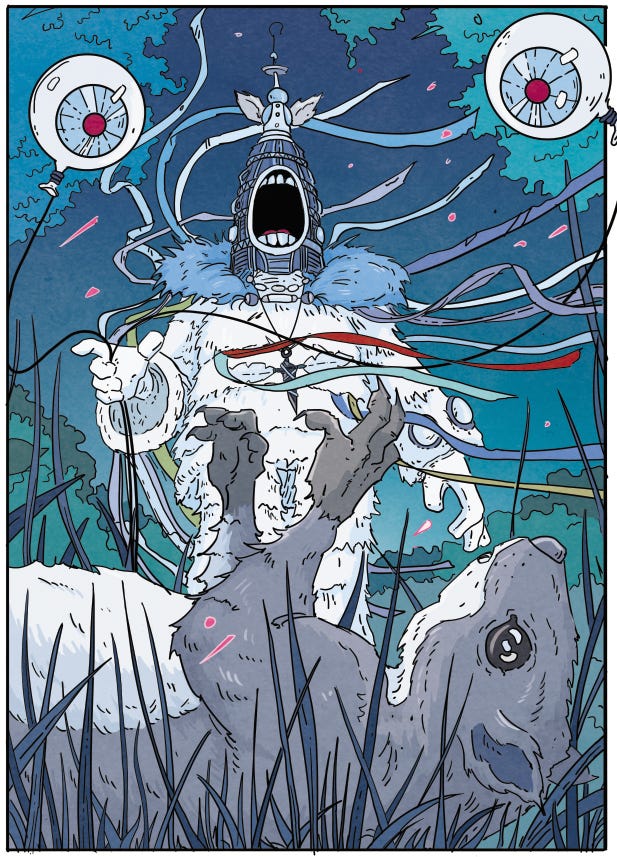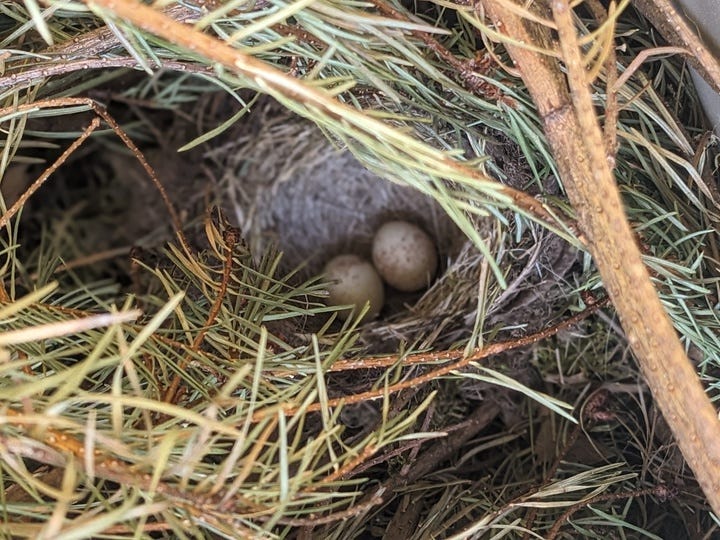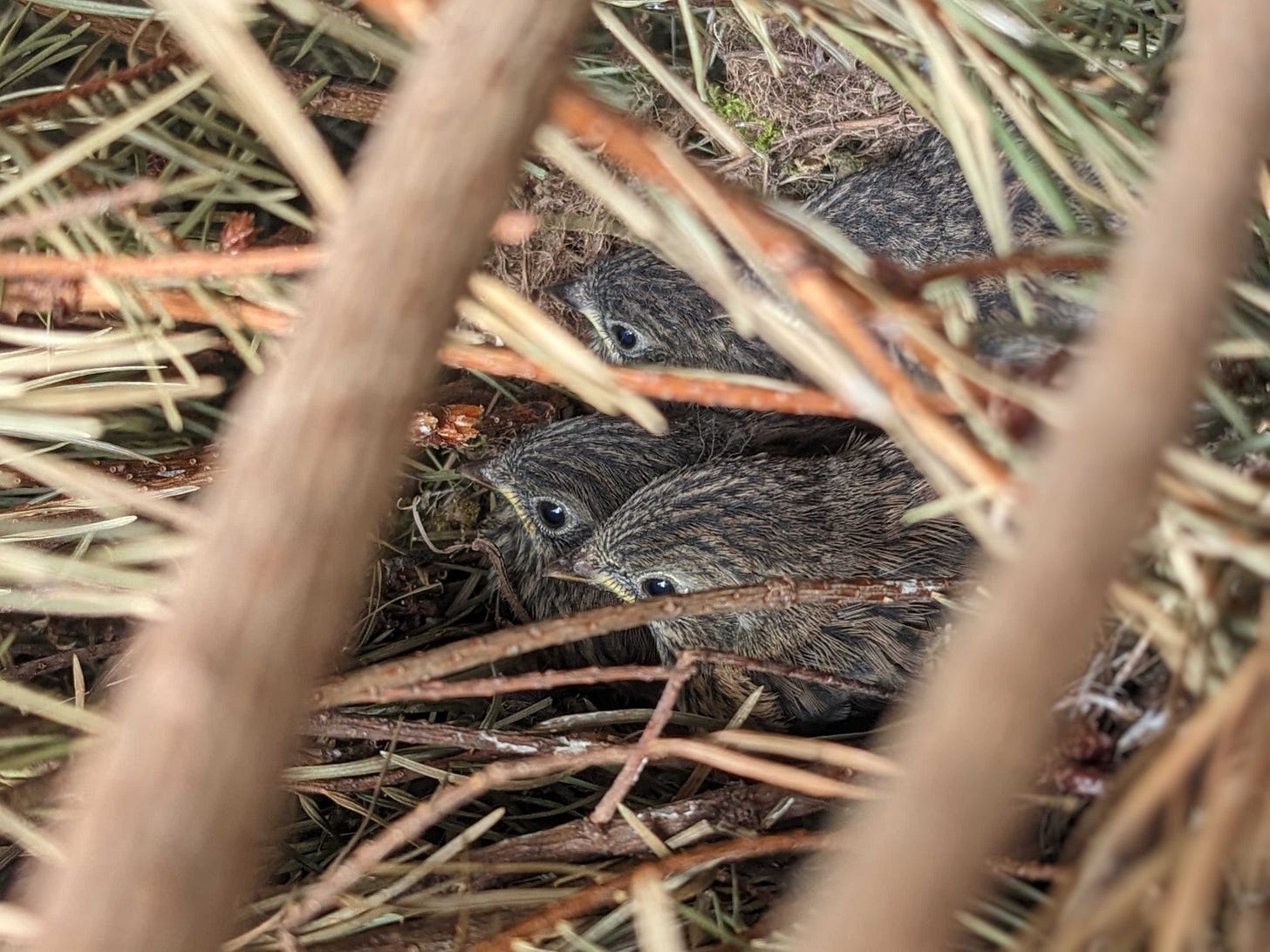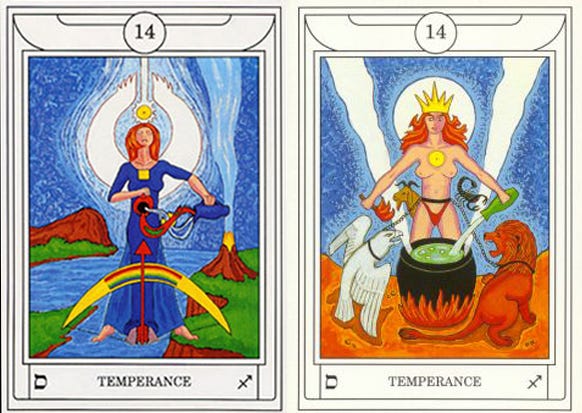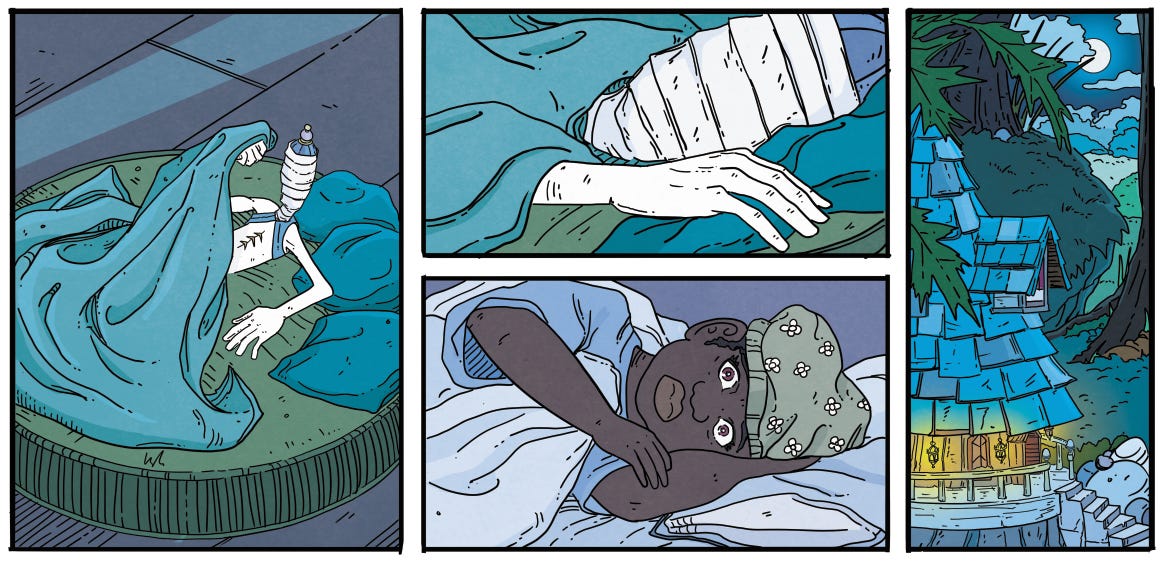May/June 2025 - Summer Solstice Special
ALA 2025 - Color Theory - Dark-Eyed Junco - Dark, Dark My Light - mewithoutYou
This special deluxe edition* of The Small Blue Mailbox is brought to you by the SUMMER SOLSTICE which is happening in the northern hemisphere today. In the sections below we will continue to honor the sun through a collection of mini-essays around the theme of LIGHT. If you need a refresher, here is last month’s collection.
Next week I will be hopping a plane back to my home city of Philadelphia, where this year’s American Library Association’s Annual Conference is being held. I’ll be doing a couple panels and signings, and chatting up librarians about occult ecology. Schedule below.
Next month: SDCC and some surprise announcements.
*Yes, there was no May newsletter, nor a June newsletter, this is a kind-of-sort-of gimmick to merge the two months into one newsletter while I try to stay on deadline. But behold, this is a long letter, and worthy of a two month slot.
As always—it goes on,
Oliver Bly
Calendar:
The Mushroom Knight - A Graphic Novel Series
Available Now!
June 26th-30th - 2025 ALA Conference & Exhibition - Schedule below
Saturday June 28th - 11:00 AM - 12:00 PM
Meet Mad Cave’s Fantasy Authors!
Oliver Bly & Pierre Alexandre Comtois
Booth 2254Sunday, June 29 - 12:30 PM - 1:20 PM
Descend into Madness: Mad Cave Studios Book Buzz
Graphic Novels & Gaming StageSunday, June 29 - 2:00 PM - 3:00 PM
Descend Into Madness: Mad Cave Group Signing
Oliver Bly, Pierre Alexandre Comtois, Amit Tishler, Mark Russell, Fred Van Lente
Booth 2254Sunday June 29th - 3:00 PM - 3:50 PM
Author Signing Session - Oliver Bly
Author Autographing Station 3
July 24th - 27th - San Diego Comic Con - Artist Alley , Schedule TBA
August 29th - 30th - Boise Comic Arts Festival - Schedule TBA
When you were young, you were probably taught that there are three primary colors: red, yellow, and blue. And by adding those colors together, you can mix the rest of the color wheel. Three little pig-ments, working together to generate the brilliant world of the painted page.

In the world of the printed page, these three colors are nuanced and hued as cyan, magenta, and yellow, and combined with a pre-mixed black ink dubbed “K tone” or “Key tone”, to create over 16,000 different colors. Referred to as “CMYK”, these four colors of ink splash onto paper to make nearly every single graphic novel or comic book in existence. What starts as a dream in a dreamer’s head is bled into reality, and through the mixture of these pigments these dreams can travel off the page, through your eyes, and into your mind—where your brain will decode, transcode, and recode the symbols relationally into its own elusive codex.
But there is another Holy Trinity here aside from CMY or red, yellow, blue. Because while these are the primary colors of pigment, they are not the primary colors of LIGHT. And if you paint with light, as I do, then it is interesting to consider human evolution, and how we evolved to perceive light.
Our very intelligent science detectives have deduced to their satisfaction that around 90 million years ago our primitive mammalian human ancestors were nocturnal and had eyeballs that were UV and red color sensitive. So we saw things very differently back then. But—Omnia mutantur nos et mutamur in illis—all things change and we change with them—and very slowly over several millions of years, humans began hanging out during the daytime and evolving better vision in order to differentiate fruits from leaves and delicious edible mushrooms from the Gowlitrot-tinted ones that will make you see, well, all sorts of things.
Thus, over time, we evolved trichromatic vision, developing Red, Green, and Blue cones in our eyes. It’s through the work of these cones that our brain is able to discern the visible spectrum of color that tints everything we see.
Pigment (paint, ink, crayon, pastels, etc.) relates color by both absorbing and reflecting light. Red pigment absorbs blue and green light and reflects red light back into your eyes. Mix together cyan, magenta, and yellow ink and they will absorb all light, and you will see something akin to black (K Tone is used partially because the CMY inks used in printing are not pure enough to make a true black, and that much CMY would leave the page soggy anyhow), depending on the potency and saturation of the pigment. Pig-ments, you see, are pig-ish. They are light thieves—what you see when you see a painting in a museum is the leftover light that the paints chose not to absorb. A painter usually starts with a white canvas, which reflects all light back into the eye. Then they use a light absorbing substance, like oil paints, to selectively decide which frequencies of light your eyes get to enjoy, based on aesthetics. To make the canvas black, they mix all of their pigments to absorb all of the light. When you see a black canvas, or a very dark canvas, you are looking at a very light hungry painting. You’re only getting the crumbs.

But those that paint with light (sometimes called magicians, sometimes called digital artists) do not paint on a canvas of white. Magicians paint on a canvas of darkness. When you mix red and green light together, you get yellow light. Mix the primary colors of light together and you don’t get black, you get white—the culmination of all. A magician looks into the darkness, and what do they say?
They say “let there be light.”
The mechanical discrepancies between the RGB light of your computer and the CMYK pigment of the printed page is why an image you took from the internet might not print accurately without conversion. Similarly, an image that is coded for print might look trippy when you view it in your eMail box. This is why we say an image file has an RGB or CMYK “profile”, meaning it is encoded to be perceived on a screen or on a printed page. The medium matters. These two color worlds need translation, and you must use an application to translate one to the other depending on whether your image will be viewed on a light-based screen, or a pigment-saturated piece of paper.
The Mushroom Knight is drawn in Photoshop, where the very smart application live-translates the light that hits my eye into a gamut of colors that are safe to print. While pigment can produce a very large amount of colors (16 thousand as I mentioned earlier), it is a pale imitation of the real thing. The RGB gamut can produce an estimated 16.7 million colors—and climbing. That’s a big box of luminescent crayons! Magic, indeed.
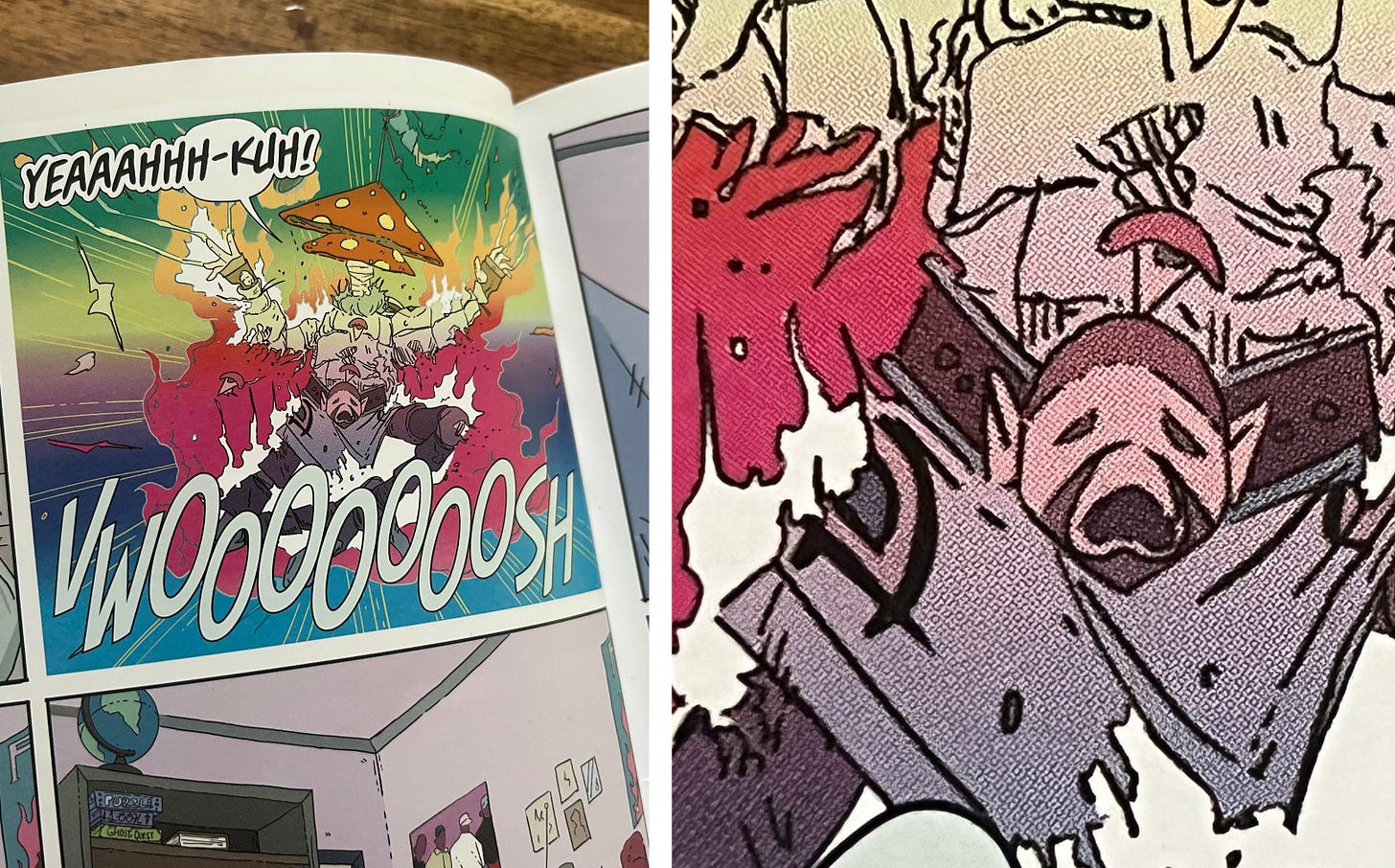
So to make The Mushroom Knight, I must walk in two worlds of color. The heavenly realm of light, and the material world of pigment—one doing the best to represent the other.
Have you noticed color in The Mushroom Knight? Keep looking. There is more here than meets the eye. And for more information about the wonderful world of color, check out this fascinating entry at Encyclopedia Britannica dot com.

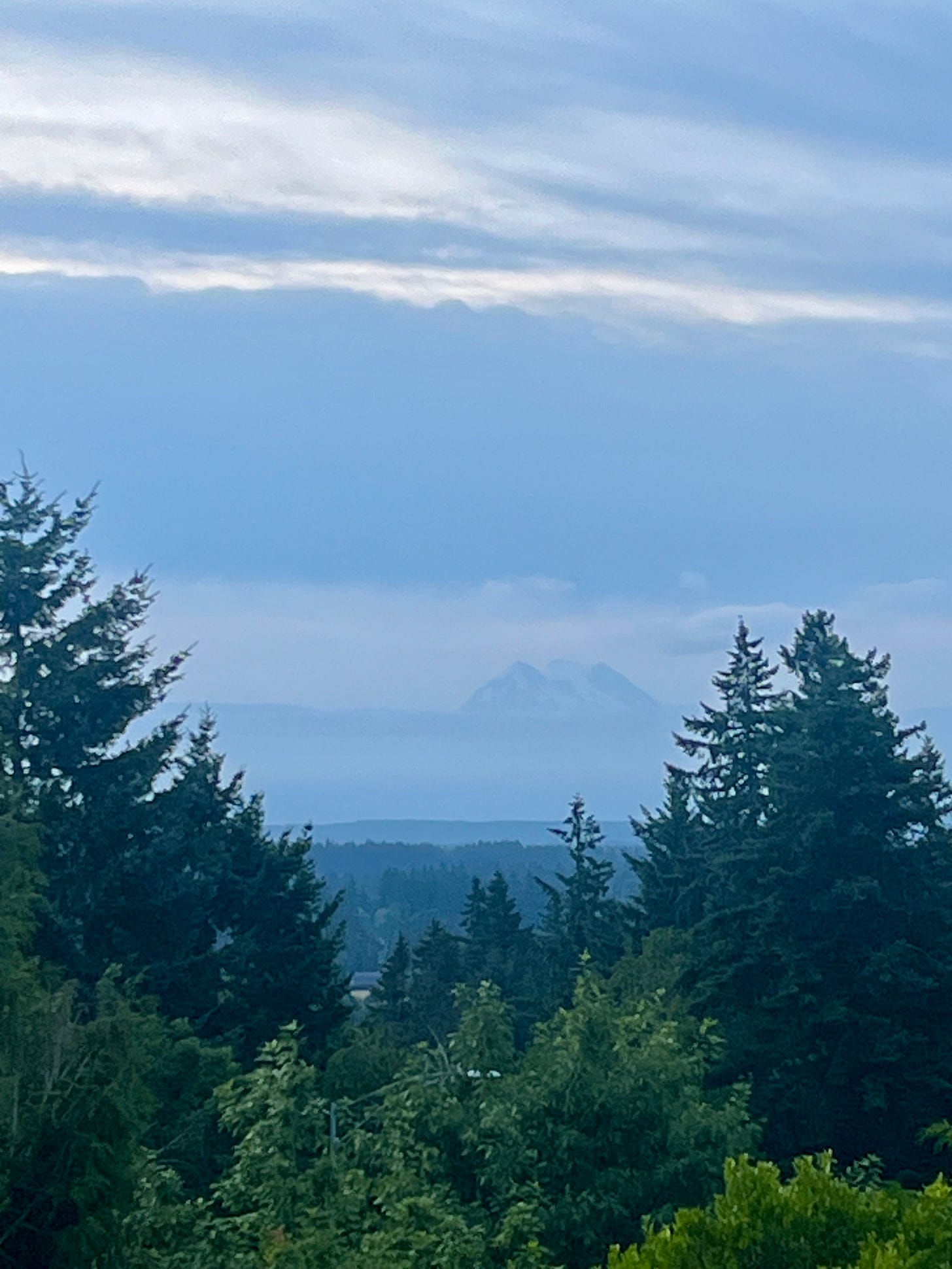
Here in Olympia, Washington we are enjoying three more seconds of daylight than yesterday. Tomorrow we will have one second less than today. Will you notice? Probably not.
Due to seasonal lag, the hottest summer weather is yet to come. In fact, in our U.S. calendar we label the summer solstice, the time when we receive the longest and highest-angled sunlight of the year, as the first day of summer. It feels counterintuitive that summer begins when the duration of daylight begins to recede.
The traditional holiday of Midsummer is celebrated on or near this time, as well, making it a little more confusing, because Midsummer celebrates, well, mid-summer. Not the first day of it. But this is a little more sensical when you take into consideration that many old school cultures only cleaved the year into two seasons. Fold spring into summertime, and this mid-summer business makes more sense.
The severe heat and humidity waiting for many of us in July and August comes after the solstice because it takes a while for the Earth to preheat. Even though the sun will be theoretically less intense next month, the cumulative effect of the Earth’s absorbed solar radiation will mean you will start baking between two elements. In that sense, it feels more like midsummer later on in the season, when the heat climaxes and begins to recede.
Last month, Steph and I discovered two dark-eyed juncos building a nest in our bin of evergreen branches while we were preparing for our Beltane bonfire.
Throughout the month we very very carefully peeped into the box to check on our visiting families’ progress. The juncos laid four eggs in total, and hatched four healthy chicks.
It only takes about thirteen days for incubating junco eggs to hatch, and another thirteen for the chicks to grow enough to fledge. At the start of June, the chicks took their first flight into the real world, which unfortunately was disturbed by our dog, Ori, who happened to be outside during their first flying lesson. Ooops.
Ori was intrigued by the fluffy, flapping fledglings, and for a moment Steph and I were worried that his enthusiasm might injure or kill one of the baby birds. Quick as lightning, the mother intervened, and cunningly lured Ori away from the grounded fledglings. She flew back and forth across our yard like a nimble fighter pilot, keeping herself only inches away from Ori’s face the entire time, inspiring him to chase her while her young fluttered for shelter in the nearby bushes.
I was awed by both the agility and the bravery of this mother bird, who boldly and instinctively manipulated my dog so well. By the second pass, Steph scooped up Ori and brought him inside. We quickly surveyed the scene to make sure they were OK before giving them space to recover from my curious but well meaning pooch’s traumatizing (but educational) intervention. It’s a hard world out there, baby birds. Good luck.
After junco fledglings leave the nest, they split up from their siblings to reduce the likelihood of a predator killing them all at once. They meep from time to time to alert their parents of their location, and their parents bring them food. This period lasts for about three weeks, at which point they begin to apprentice with their adults, flying around and catching their own food.
So for the last couple of weeks our backyard has been hemmed in by meeping teenagers, but now, as the solstice is upon us, our little fledglings have learned to fly and have moved on from our backyard abode.
It is always wonderful to pay attention to what is happening in the nooks and crannies of the world around you. When you look at things from the perspective of a news website each day, it is easy to become people-obsessed. But getting outside of our “self”, or ourselves, is a handy trick to feel happy and at peace, and connected to something bigger than our distracting human messes. There is more to human nature than humans.
Now that the days are getting shorter, if we want to continue talking about LIGHT, it’s appropriate that we begin to talk about DARKNESS, as well.
We have a tendency to apply “good” and “bad” labels to things. Perhaps it is an evolutionary necessity to sort the massive amount of information our brains process each day into a shorthand binary. This or that, and move on. Keep it simple, keep it clean… even if the oversimplification borders on fallacy.
If you had to choose between darkness and light, which one would you choose? Which one is good, and which one is bad?
Obviously, that’s a trick question. But pop culture often uses darkness synonymously with evil. When you hear “the Forces of Darkness” what do you imagine? An army of sinister orcs?
That would make sense. Things are a bit scarier at night for our fragile human bodies. We might get eaten by a nocturnal predator hiding in the shadows, which sounds unpleasant. Darkness obscures vision, and when you can’t see, you’re more vulnerable. So there is fear. We used to be able to see in the dark, but we can’t do this anymore, not without our friend Fire. Children are probably instinctually afraid of the dark to stop them from wandering out into the jungle while their parents are asleep. The jungle, at night, is perilous to children. So fear is useful.
But if you think light is only ever good, spend a day walking through a desert in high summer with no hat upon your head. The light will melt the skin from your face. The light will give you cancer. The light will shrivel your crops, dry up your water. Too much light is deadly. We often bemoan winter, but summer can also be quite devastating, depending on where you are located on this planet.
So what function does light play in the spiritual metaphor, if it’s not an ever present synonym for “good”?
LIGHT is what allows you to SEE. And DARKNESS gives you a break from seeing. The two work in tandem, and through their interrelating we grow as people, and evolve as a spiritual species.
That’s it. Both can be medicine, and both can be abused, depending on your particular situation. Become an extremist and polarize either way, and you will fall sick and hurt those around you. Being lost in darkness isn’t good, but being light-blinded isn’t good, either.
Oftentimes we get LIGHT mixed up with DARKNESS. As in, we think we are going through a dark time, but really the lights are turned on and subsequently we can see things that we’d rather not see. In my first issue of The Small Blue Mailbox, I included one of my favorite poems by Theodore Roethke - “In a Dark Time” - which begins with this spell:
“In a dark time, the eye begins to see”
In high school I worked at a somewhat run-down Italian sports bar and grill. At 2am, after the patrons left, all of the remaining servers would turn up the lights so we could thoroughly clean up the hidden grit and grime and spilled ketchup and napkins stuck into the folds of the booths. Under the bright lights you could see that the furniture was old and sticky, the (hopefully not asbestos) floor tiles were cracked and broken in places, and the once white drop ceiling was stained brown from cigarette smoke. The artwork was faded and there was a permanent layer of dust stuck into the decomposing varnish covering the old wooden bannisters, which had grown tacky by several decades’ worth of human hand grease. The place looked like absolute #@$% under the bright lights. It was my job to scrub the bar mirrors every other week in order to remove the accumulated cigarette tar and as I looked at the yellowish brown paper towels in my hands, I thought “this film is on everything in here, and inside the people, but no one can see it, and no one is cleaning it.”
“Ew.”
Our world is very much like that Italian grill. The world, in daylight, is perilous for adults.
Many holy paths use language like “enlightened,” “illuminated,” and “awoken” to describe someone who can hang out in the day without getting sunburned. But most actual holy people would shoo you off from trying to be any of those things until you’ve had decades of spiritual practice. Why?
David Lynch illustrates a “mushroom night” in Twin Peaks: The Return
Try gazing into a nuclear blast without blinking or going blind. Without getting burned alive at the molecular level. This is what it means to look at the truth of the world and the truth of yourself. You need a powerful set of peepers to take it all in. If you think this sounds a little overblown, you may want to look closer. Human civilization is built on trauma. Look closer.
That’s why all those holy people are always doing all of those holy activities, like meditating and contemplating, and looking at pretty trees. And this is why they are doing those things every day with discipline. They are gaining levels, they are growing in capacity, they are cleansing, and purging, and making space. They are not only training their eyes to see; they are training their souls to hold what it is they saw while still retaining equilibrium; while still retaining mental health and the reciprocal love of the Universe which is often called GOD. To hold all of the cruelty and abuse of the world in one hand, and its splendor and joy in the other, is an extreme balancing act that takes a lifetime (lifetimes?) to master. Pressing the contents of both hands together, and making a new thing out of those things, and loving that thing, and becoming that thing, is one of the works of High Magic.
When you look at the news of the day and despair, it’s not because of darkness—it’s because the light is showing you the tobacco stains on the walls. The truth can be too cruel to handle, too gross to be believed. Your precious heart wants to exist in inner and outer worlds that aren’t as sad and vicious as the ones it so often finds itself in. The problem has nothing to do with light or dark. The problem is that our common education does not capacitize humans to see the world in incandescence, to see things how they really are. See the current war on American education—what is being hidden and why? The light burns. But the meanings of life can only be found with eyes wide OPEN.
You may have heard of the term “the dark night of the soul.” You might have even gone through one. I’ve gone through a few. One thing I’ve learned about the dark night of the soul is that it’s not really the darkness that is the problem. You start going through a dark night of the soul when the lights start to turn on and you are no longer able to pull the sleep mask over your eyes. You see things about yourself, your friends, your family, your neighbors, your communities, your society, your civilization, your world, that your brain had turned a blind eye to in order to preserve a sense of tentative happiness that is generated through fantasy. And now you can’t look away. This is why our “current moment” is so difficult. You cannot look away. Every day, there it is, in your pocket and in your eyes.
The dark night of the soul is when honesty and wisdom and awareness have found you so authentically that your coping mechanisms no longer help you to cope. No amount of weed or alcohol or video games or promotions or sex or professional recognition or whatever it is will ever scratch the itch on the back of your being, and now that you know that, you’re kind of stuck. You have nothing to chase, and nowhere to go. That itch needs to be confronted, but you are terrified to open the door that conceals it, because behind that door is something so terrible and stupendous it cannot be symbolized by words.
The human brain is a fantasy machine. The uninitiated consciousness is photophobic; truth can cause it discomfort and pain. You see, we are master liars. The unconscious is a real thing. People do not believe it exists within themselves, but we can see it all around when people self-sabotage or self-immolate or are “their own worst enemy” or “fail to live up to their potential.” Our true selves are not always piloting our bodies and our thoughts. People form personalities in childhood to cope with a world they are unaware they are coping with, and they live out these familiar and familial patterns even if they time and time again yield unsatisfactory results. People try to fit square pegs into round holes, and are strangely surprised at how surprised they are at having chosen to do such a curious thing. Can you do something on purpose, if there are more than just one of “you” holding the controls?
Turning the lights on can be devastating. The psyche can be vicious in order to protect stasis, even if it’s an unpleasant status quo. Opening up the darkest door means death for many of its parts, and it will fight tooth and nail using every weapon in its arsenal to keep itself alive. Do. Not. Go. In. There. And under no circumstances turn on the lights.
These parts of you would rather you spend your life with a lot of square pegs and round holes, than allow yourself to change, and them to die. This is why “death” and “rebirth” show up so much in our soul stories, in our myths, and in our spiritual communities. In order to see, you may need to kill the guy who has been holding his hand over the light switch this entire time.
Have you ever tried to have a conflict or repair a relationship with someone who has hurt you, but who does not yet have the capacity to hear the truth about an aspect of their being that is still in shadow? You may have turned on the lights and they felt burned. And they may have reacted to you as if you were burning them alive. Because, in some ways, you may have been.
So what to do with DARKNESS and LIGHT? If you’re earnest and true, I promise the answers will come to you in time. That isn’t a cop out, but it is the sticky wicket of wisdom. If you don’t find the answers for yourself, they aren’t the answers for your self.
As always, I’d suggest we learn from the natural world: because we are the natural world.
The sun rises, and it sets. We wake, and we sleep. Every summer has its fall, but every winter has its spring.
The path to the mountain is through the woods. Keep walking.
For your consideration, The Beetle King on a Coconut Estate, by my friend Mike’s band mewithoutYou.








